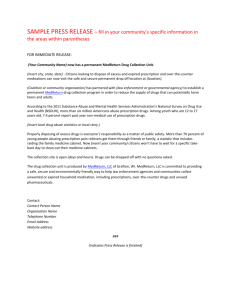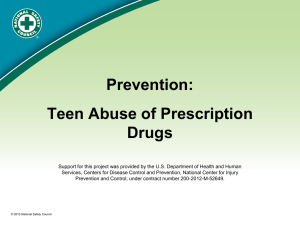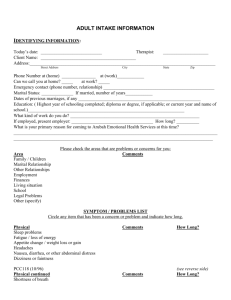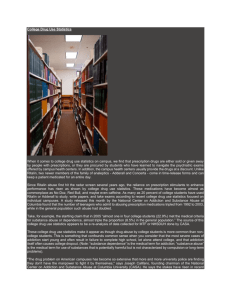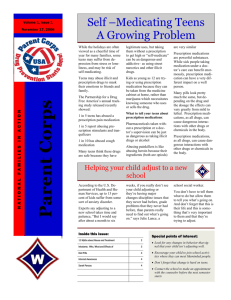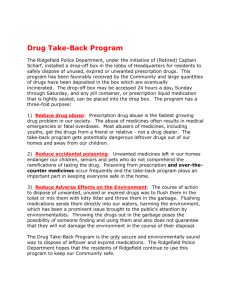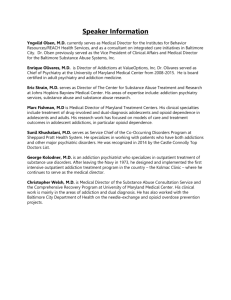Sample Op-Ed - Prevent Rx Abuse
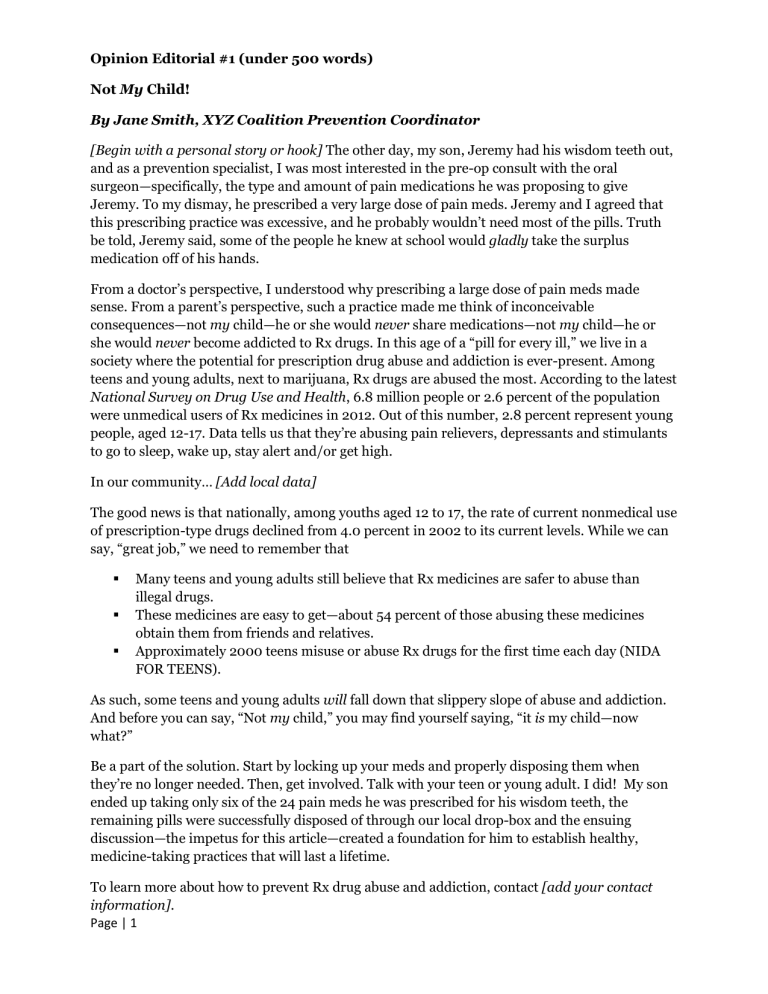
Opinion Editorial #1 (under 500 words)
Not My Child!
By Jane Smith, XYZ Coalition Prevention Coordinator
[Begin with a personal story or hook] The other day, my son, Jeremy had his wisdom teeth out, and as a prevention specialist, I was most interested in the pre-op consult with the oral surgeon—specifically, the type and amount of pain medications he was proposing to give
Jeremy. To my dismay, he prescribed a very large dose of pain meds. Jeremy and I agreed that this prescribing practice was excessive, and he probably wouldn’t need most of the pills. Truth be told, Jeremy said, some of the people he knew at school would gladly take the surplus medication off of his hands.
From a doctor’s perspective, I understood why prescribing a large dose of pain meds made sense. From a parent’s perspective, such a practice made me think of inconceivable consequences—not my child—he or she would never share medications—not my child—he or she would never become addicted to Rx drugs. In this age of a “pill for every ill,” we live in a society where the potential for prescription drug abuse and addiction is ever-present. Among teens and young adults, next to marijuana, Rx drugs are abused the most. According to the latest
National Survey on Drug Use and Health, 6.8 million people or 2.6 percent of the population were unmedical users of Rx medicines in 2012. Out of this number, 2.8 percent represent young people, aged 12-17. Data tells us that they’re abusing pain relievers, depressants and stimulants to go to sleep, wake up, stay alert and/or get high.
In our community… [Add local data]
The good news is that nationally, among youths aged 12 to 17, the rate of current nonmedical use of prescription-type drugs declined from 4.0 percent in 2002 to its current levels. While we can say, “great job,” we need to remember that
Many teens and young adults still believe that Rx medicines are safer to abuse than illegal drugs.
These medicines are easy to get—about 54 percent of those abusing these medicines obtain them from friends and relatives.
Approximately 2000 teens misuse or abuse Rx drugs for the first time each day (NIDA
FOR TEENS).
As such, some teens and young adults will fall down that slippery slope of abuse and addiction.
And before you can say, “Not my child,” you may find yourself saying, “it is my child—now what?”
Be a part of the solution. Start by locking up your meds and properly disposing them when they’re no longer needed. Then, get involved. Talk with your teen or young adult. I did! My son ended up taking only six of the 24 pain meds he was prescribed for his wisdom teeth, the remaining pills were successfully disposed of through our local drop-box and the ensuing discussion—the impetus for this article—created a foundation for him to establish healthy, medicine-taking practices that will last a lifetime.
To learn more about how to prevent Rx drug abuse and addiction, contact [add your contact
information].
Page | 1
Jane Smith is the Prevention Coordinator for XYZ Coalition—Silver Spring, MD. Ms. Smith has served as the Coalition’s Prevention Coordinator for the past 15 years, specializing in youth issues. She is also the proud mother of an NCAA gymnast and a teenage actress.
Opinion Editorial #2 (500+ words)
Not My Child
By Jane Smith, XYZ Coalition Prevention Coordinator
[Begin with a personal story or hook] Prescription medicine—a critical piece of our cultural fabric—“a pill for every ill”—all you have to do is turn on the TV, listen to the radio or view ads on the Internet or in the newspaper to see and hear about the latest medicine that can cure migraines, treat pain and stress, keep you more alert, help you sleep or address depression. We walk that fine line between ensuring access to needed medications to preventing misuse/abuse and addiction.
Just the other day, my son, Jeremy had his wisdom teeth out, and as a prevention specialist, I was most interested in the pre-op consult with the oral surgeon—specifically, the type and amount of pain medications he was proposing to give Jeremy. To my dismay, he prescribed a very large dose of pain meds. Jeremy and I agreed that this prescribing practice was excessive, and he probably wouldn’t need most of the pills. Truth be told, Jeremy said, some of the people he knew at school would gladly take the surplus medication off of his hands.
We found ourselves thrust in the middle of the prescription drug abuse problem. How much pain medication would he need? Where would we store the medicine, and how would we discard it after we were done? You say, “Why have this discussion—it won’t be my child.” He would
never share medications, nor would he ever abuse or become addicted to this medicine.” Indeed the discussion was a great exercise, and I was proud of Jeremy when he said, “you take care of the pain meds, Mom.” Prevention works!
In this age of a “pill for every ill,” we live in a society where the potential for prescription drug abuse and addiction is ever-present. Among teens and young adults, next to marijuana, Rx drugs are abused the most. According to the latest National Survey on Drug Use and Health,
6.8 million people or 2.6 percent of the population were unmedical users of Rx medicines in
2012. Out of this number, 2.8 percent represent young people, aged 12-17. Data also tells us that they’re abusing pain relievers, depressants and stimulants to go to sleep, wake up, stay alert and/or get high.
In our community… [Add local data]
The good news is that nationally, among youths aged 12 to 17, the rate of current nonmedical use of prescription-type drugs declined from 4.0 percent in 2002 to its present level. While we can say, “great job,” we need to remember that
Many teens and young adults still believe that Rx medicines are safer to abuse than illegal drugs.
These medicines are easy to get—about 54 percent of those abusing these medicines obtain them from friends and relatives.
Page | 2
Approximately 2000 teens each day misuse or abuse Rx drugs for the first time (NIDA
FOR TEENS).
As such, some teens and young adults will fall down that slippery slope of abuse and addiction.
Before you can say, “Not my child,” you may find yourself saying, “it is my child—now what?”
We see the more visible signs of Rx abuse every day:
Philip Seymour Hoffman—died of a heroin overdose, triggered by an addiction to prescription pain medicines.
Whitney Houston—died of an overdose of cocaine and prescription drugs.
Heather Ledger—died of an overdose of sleeping pills—both prescription and over-thecounter.
Michael Jackson, Marilyn Monroe, Anna Nicole Smith, Brian “Crush” Adams
(professional wrestler) and Ken Caminiti (1996 Most Valuable Player-played for Houston
Astros, San Diego Padres and the Atlanta Braves)—died of prescription drug overdose.
Out of the spotlight are the teens and young adults who abuse and may become addicted to these Rx drugs. We need to protect our teens and young people. Be a part of the solution. Start by locking up your meds and properly disposing them when they’re no longer needed. Then, get involved. Talk with your teen or young adult. I did! My son ended up taking only six of the 24 pain meds he was prescribed for his wisdom teeth, the remaining pills were successfully disposed of through our local drop-box and the ensuing discussion—the impetus for this article—created a foundation for him to establish healthy, medicine-taking practices that will last a lifetime.
To learn more about how to prevent Rx drug abuse and addiction, contact [add your contact
information].
Jane Smith is the Prevention Coordinator for XYZ Coalition—Silver Spring, MD. Ms. Smith has served as the Coalition’s Prevention Coordinator for the past 15 years, specializing in youth issues. She is also the proud mother of an NCAA Gymnast and a teenage actress.
Page | 3

